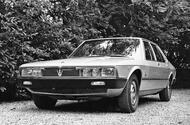Maserati’s Disastrous Quattroporte: A Forgotten Chapter in the Brand’s History

After 11 years, production of the Mk6 Quattroporte has finally come to an end. Maserati had high hopes for this suave sporting limousine, expecting it to boost annual sales to 50,000 units. However, the Quattroporte fell short of expectations, consistently being outsold by the BMW 7 Series. The car’s eccentric design, high prices, and lack of updates are to blame for its underperformance.
A Forgotten Disaster: The Second-Generation Quattroporte
While the Mk6 Quattroporte’s sales may have been disappointing, Maserati can take solace in the fact that things could have been much worse. The second-generation Quattroporte, in particular, was a complete disaster. Only 13 examples of this model were ever built, a shockingly low number even by luxury car standards.
The original Quattroporte, introduced in 1961, was a game-changer for Maserati. It set the standard for rear-wheel drive, powerful V8 engines, and a perfect balance of comfort and athleticism. The car sold nearly 800 units, an impressive feat considering the small luxury car market at the time.
Work on a replacement began when Maserati entered a joint venture with Citroën, who sought their expertise in developing their first GT car, the SM. The second-generation Quattroporte and the SM shared the same chassis, a front-driven axle, a 3.0-liter V6 engine, and a unique hydropneumatic suspension. Design responsibilities were transferred from Pietro Frua to Marcello Gandini of Bertone.
When the second-generation Quattroporte debuted at the Paris Motor Show in 1974, it received mixed reviews. Autocar was somewhat dismissive of the car due to its all-Citroën running gear. However, they acknowledged its potential as a luxurious and comfortable long-distance touring car.
Unfortunately, the second-generation Quattroporte never had a chance to prove itself. Citroën’s financial struggles led to their acquisition by Peugeot in December 1974. As a result, Maserati’s operations were suspended in June 1975 due to significant losses. The sudden 1973 oil crisis also played a role in the downfall of expensive luxury car brands.
Although plans for a Rolls-Royce-rivalling Maserati limousine with a bespoke 5.5-liter flat 12 engine were scrapped, Maserati managed to resume operations within days. The Italian government and fellow Modena marque De Tomaso provided a lifeline, allowing limited production of the Quattroporte to continue in 1976.
Despite its revival, the second-generation Quattroporte faced numerous challenges. Alejandro de Tomaso, the head of Maserati at the time, criticized the car for being too heavy, having a small engine, and causing servicing problems due to its suspension. Plans for a new 4.0-liter V8 version were also canceled.
The second-generation Quattroporte never received type approval for sale in the EEC, so production was mainly focused on fulfilling orders from the Middle East, South America, and Spain. The priority for Maserati at the time was to produce successful models like the Bora, Merak, Khamsin super-coupés, and the new De Tomaso-based Kyalami GT.
Unfortunately, there are no known reviews of the second-generation Quattroporte, and only a handful of surviving examples exist in Belgium, France, and Germany. The car remains an elusive and forgotten chapter in Maserati’s history.